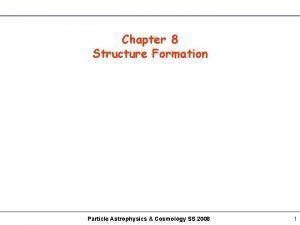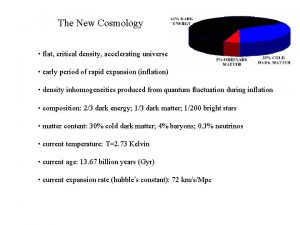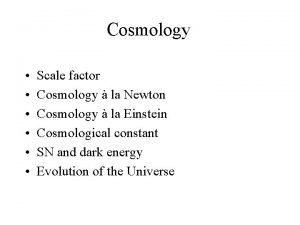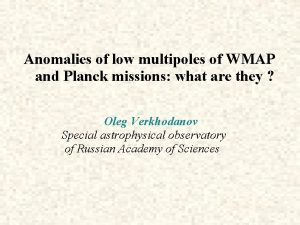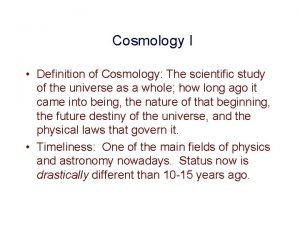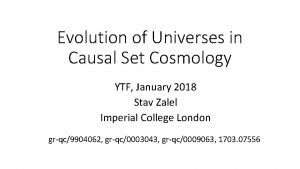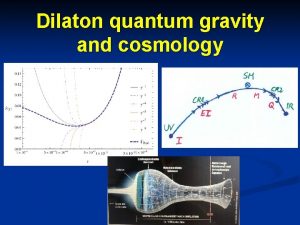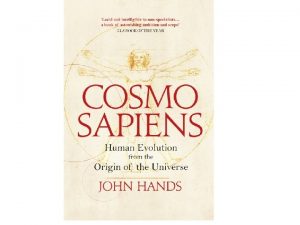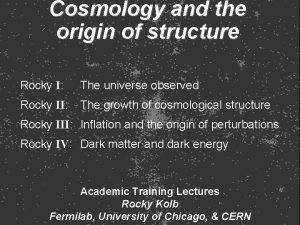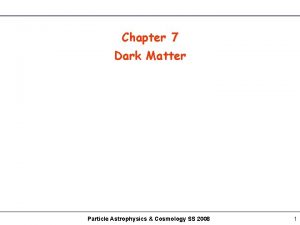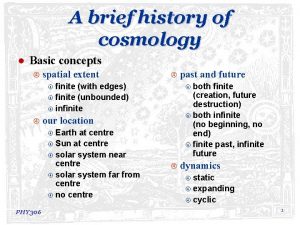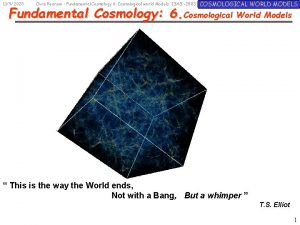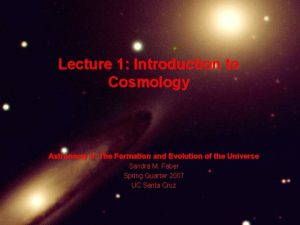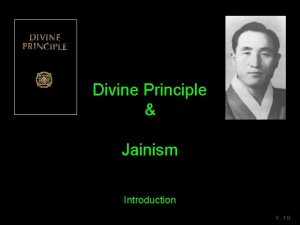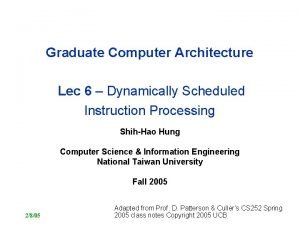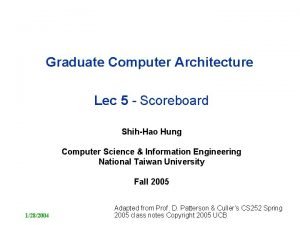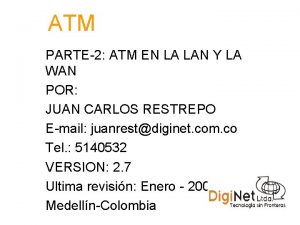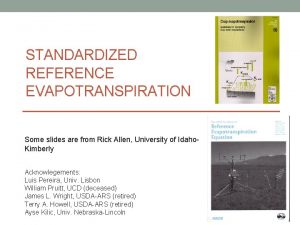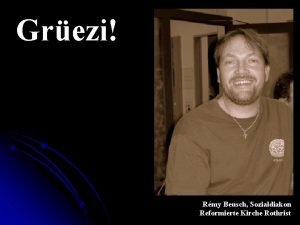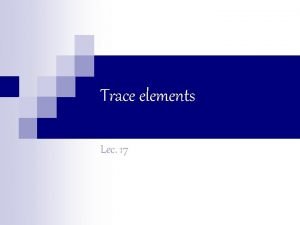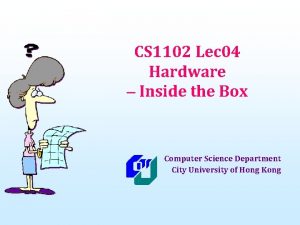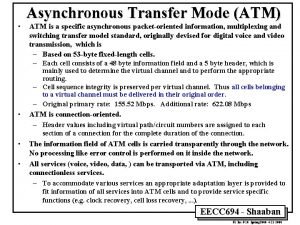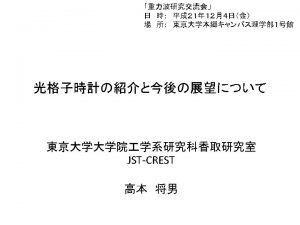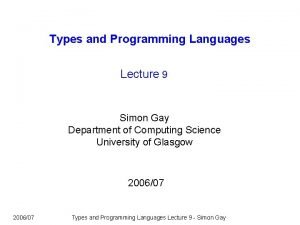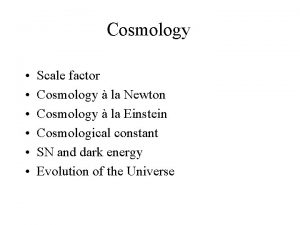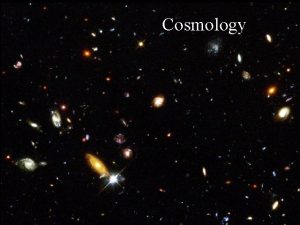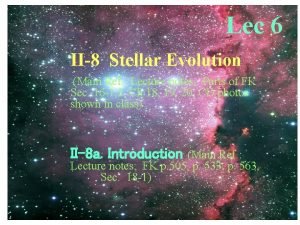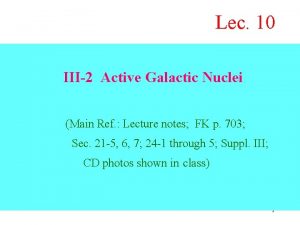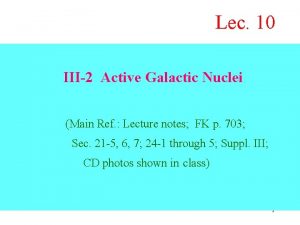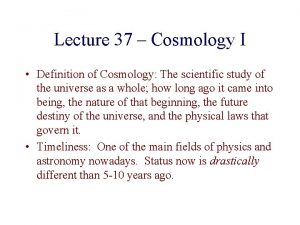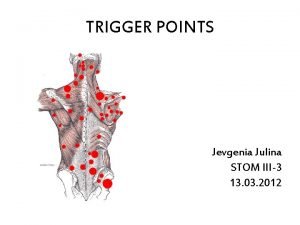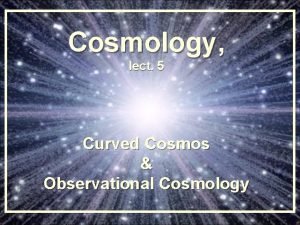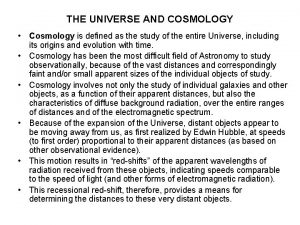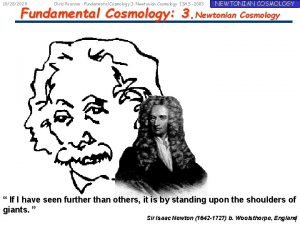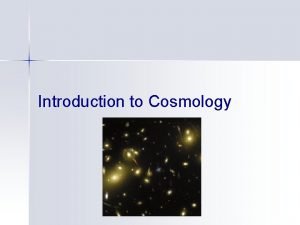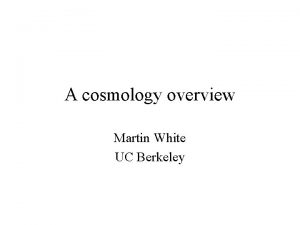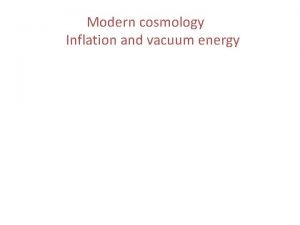Lec 11 III3 Cosmology Main Ref Lecture notes













































- Slides: 45

Lec. 11 III-3 Cosmology (Main Ref. : Lecture notes; FK p. 721; Sec. 171, 17 -8, 19 -6, 22 -4, 23 -4 & 8, 25 -1 through 7) 1

III-3 a. Introduction (Ref. : Lecture notes; FK p. 721, Sec. 25 -1& 2) (i) Steady Universe vs Evolutionary Universe: Static, Steady Universe; = static, infinite expanse of universe, with no evolution – the universe is infinitely old and lasts forever, with no major change of structure. Evolutionary Universe; = non-static universe, with evolution – the universe changes with time leads to the big bang cosmology! Note: Einstein’s general theory of relativity gives NO solution for the static universe – which means the universe is either expanding or it will collapse. However, in those days (when he derived the equations for general relativity first time), before Hubble’s discovery of expansion of the universe, the universe was considered to be static. To solve this problem, Einstein introduced , cosmological constant, to make his 2 solution for the collapsing universe to become static.

When Einstein learned the observational discovery by Hubble that the universe is indeed expanding, he said that is the greatest mistake of his life and took it out, i. e. , set = 0 since he got expanding solutions. However, as we will explain later in Section III-3 c we do now need , after all. Einstein’s mistake is NOT that = 0, but that it must be much larger than he predicted! See later sections. (ii) Expanding Universe: Hubble’s discovery, Hubble Law, established that the universe is expanding. *Hubble Law: vc = H 0 d, Eqn(III-15) where vc is receding velocity due to cosmological redshift; 3 d is distance, and H 0 is Hubble’s constant, and

d = vc / H 0 = z c / H 0. Eqn(III-16) where z = cosmological redshift. Hubble Law is covered already. See Sec. II-9 (iii). Note: Most advocates of the steady state cosmology gave it up since Hubble’s discovery, although some still fight for it, e. g. , Arp, G. Burbidge. However, one of the strongest advocates, Sir Fred Hoyle, died in August 2000. *Cosmological Principle: = Assumption that the universe is homogeneous and isotropic in large enough scale, > 100 Mpc (e. g. , beyond the scale of largest clusters of galaxies) – well supported by observations. Adopted by Einstein when he developed his general theory of relativity. 4

The redshifts that we see from distant galaxies are caused by this expansion, not by the motions of galaxies through space The redshift of a distant galaxy is a measure of the scale of the universe at the time the galaxy emitted its light Fig. III-73: Cosmological Redshift 5

III-3 b. Big Bang Cosmology and Microwave Background Radiation (Ref. : Lecture notes; FK Sec. 25 -3 through 6) (i) Hot Big Bang Theory: (Ref. : Lecture notes; FK Sec. 25 -3 and 5) The expanding universe emerged from a cataclysmic event called the Big Bang • The universe began as an infinitely dense cosmic singularity which began its expansion in the event called the Big Bang, which can be described as the beginning of time • During the first 10– 43 second after the Big Bang, the universe was too dense to be described by the 6 known laws of physics

If the universe has been expanding, then, if we go back, the universe will get denser, until the point in time when the density gets infinite – the state called singularity, when something, e. g. , like an `explosion’, may have happened This singularity with density = , then, takes place at ~ 15 billion years ago. G. Burbidge, who still believes the steady state cosmology, coined this `singularity’ state, BIG BANG, which was adopted by the community. This singularity is more like inside of a black hole, where the distinction between space and time disappears. So, this is more like the beginning o the universe as we know it. We do not know what things were before and at the big bang, because physics as we know does not apply there! 7

. *Planck Time t. P: However, not only before and at the moment of the big bang, but also after the big bang but before Planck Time t. P, classical mechanics breaks down. Planck Time is defined as: t. P = square root of (G h / c 5 ), Eqn (III-17) where G = gravitational constant, h = Planck constant, and c = velocity of light. During time t < t. P, classical mechanics breaks down, and so quantum mechanics must be used. Since it is near singularity (i. e. , infinite density, like the center of a black hole), general relativity must be used. The combination of the two, called `Quantum Gravity’ is a very difficult field. Although some excellent ambitious physicists are attacking quantum gravity, the problems are not fully solved yet. Therefore, we do not know what went on during 0 < t. P, although some speculate that singularity may be avoided at t = 0 if we adopt 8 quantum gravity correctly.

*Why Hot Big Bang? - Helium Problem: We now know that elements heavier than He (Z > 2) were produced through nucleosynthesis during the presupervona stages of massive stars. However, typical composition of ordinary stars is about 74% Hydrogen, 25% Helium, and 1% heavier elements (`metals’, i. e. , elements with Z > 2 ). There is no way to produce 25% helium by nucleosynthesis within stars. Earlier we noted that high temperature of T > T☉c (core temperature of the sun) = 1. 6 x 107 K is required for hydrogen burning to convert H to He. Here comes need for Hot Big Bang! °Idea: The universe was very hot right after the big bang. As it expands, it cools down. In the earliest stage, radiation (photons) and particles (first quarks but then protons and electrons) coexist. When T > ~ 107 K in the hot universe, H-burning converts H to He. When ~ 25% were converted to He, the universe has cooled down to T < ~ 107 K, and H-burning stops. 9 In this way the He problem is solved.

• The observable universe extends about 14 billion light -years in every direction from the Earth Fig. III-74: The Observable Universe We cannot see objects beyond this distance because light from 10 these objects has not had enough time to reach us

*Age of the Universe To: We can roughly estimate age of the universe by assuming the universe has been expanding uniformly at the constant rate (ie. , Hubble Constant Ho = constant with time). Then, To = d / v (where d = current separation between two galaxies and v = velocity with which they are separating). Then, from Hubble Law, Eqn(III-15), we get: T 0 = 1 / H 0. Eqn (III-18) See class notes for derivation EX 62: If Ho = 70 km/sec-Mpc, what is To? Ans. To = 14 billion years. See class notes for details. 11

Note: The oldest observed stars are in globular clusters, which are ~ 12 – 16 billion years old. The numbers roughly agree, and so o. k. (Remember that the time after the big bang before first stars are created must be very short compared with the age of the current universe. ) Note: Later, we will learn that Ho has not been constant with time (see Section III-3 c), but this rough estimate is still o. k. – tells roughly the age of the universe – the uncertainty involved (mostly due to the uncertainty in distances which causes uncertainty in the Ho value) is larger. (ii) Evolution of the Universe: (Ref. : Lecture notes; FK Sec. 25 -5) After the hot big bang, the universe expands and cools down. What will Happen as time goes on? 12

Radiation Dominated Era and Matter Dominated Era: *The universe is made of matter and energy. Through Einstein’s E = m c 2 , Eqn (III-19) energy E and mass m are similar – They can be converted from one to the other. *Radiation density R: Define radiation energy ER and the equivalent mass for radiation m. R, for convenience. Then, mass density for radiation R = m. R/volume will become: Fig. III-44: Evolution of Density Fig. III-75: The Evolution of Density 13

R = 4 T / c 3 , Eqn (III-20 a) (Blackbody) where = Stefan Boltzman constant, c = velocity of light, and T is the temperature of microwave background radiation today, which is T = 2. 725 K (see next Section (iii)). (Derivation of Eqn(III-20 a) skipped. ) Then, Eqn(III-20 a) gives: R = 4. 6 X 10– 31 kg/m 3, Eqn (III-20 b), now. *Total matter density m: = total mass of all matter in the universe/volume today, including all matter emitting radiation (e. g. , stars, galaxies, nebulae, etc. ), and `invisible’ dark matter. Then, observation gives: m = (2 – 4) X 10– 27 kg/m 3, Eqn (III-21), now. That means, today the universe is matter dominated. However, that is not so earlier, because radiation density declines more steeply with time, than matter density does (see Fig. III-75). 14

Then, we find m = R, at time t. M, where: t. M = 2500 years (after the big bang); when z. M = 25, 000; M = 40 nm; and TM = 75000 K (comes in UV), where z. M = redshift, M = wavelength of em radiation (photons), and TM = temperature, at time t. M. The period BEFORE t. M; t < t. M; is called Radiation Dominated Era. The period AFTER t. M; t > t. M; is called Matter Dominated Era. See class notes for further details. Recombination Era: After t. M, as the universe keeps cooling down, another critical time t. R is reached when temperature TR is so low that protons and electrons combine to make Hydrogen atom. Here, t. R = 3 x 105 years, with redshift z. R = 1000, and TR = 3000 K. The period AFTER t. R is called Recombination Era. Note: blackbody radiation photons at 3000 K is visible red light. 15

Note: Before t. R, both protons and electrons are free – matter is called ionized `plasma’ (charged particles). Then, photons hit the particles and scatter – random walk (like inside the sun). That means the matter is NOT transparent, but opaque. This hot opaque matter with photons is sometimes called `primodial fire ball’. After t. R, however, when electrons and protons are combined and become atoms, photons do Fig. III-76: Evolution of Radiation Temperature NOT interact with H atoms – they travel freely, meaning the matter becomes transparent to photons. Since photons and matter do not interact, they no longer have the same temperature. Until t. R, photons and matter have the same temperature. (See Fig. III-76. ) (See class notes for further details. ) 16

Fig. III-77 a: The Era of Recombination (before) 17

Fig. III-77 b: The Era of Recombination (after) 18

Formation of Stars and Galaxies: Right after t. R, stars and galaxies are formed out of density fluctuations at t. R (see Section (iii) below). Which are formed first is still controversial. See class notes for the details. (iii) Cosmic Microwave Background Radiation - CBR: (Ref. : Lecture notes; FK Sec. 25 -4) The microwave radiation that fills all space is evidence of a hot Big Bang. The background radiation was hotter and more intense in the past • The cosmic microwave background radiation, corresponding to radiation from a blackbody at a temperature of nearly 3 K, is the greatly redshifted remnant of the hot universe as it existed about 19 380, 000 years after the Big Bang

• During the first 380, 000 years of the universe, radiation and matter formed an opaque plasma called the primordial fireball • We can never see photons from t < t. R because matter is opaque, but we should be able to see photons emitted at t. R because matter is transparent for t > t. R. These photons should have reached us here today. However, due to the expansion of the universe, the wavelength should have stretched to the microwave region. Fig. III-78 a: The Spectrum of CBR 20

(i) (ii) Fig. III-78 b: (i) The Bell Labs Horn Antenna (ii) COBE 21

★Peebles and Dicke of Princeton predicted that if the hot big bang theory is correct, we should detect this microwave background radiation. Indeed, Penzias and Wilson of Bell Lab discovered this CBR, for which they received Nobel Prize. From Big Bang Theory we can calculate the wavelength we should detect today, and then from Wien’s Law for blackbody radiation we can calculate the temperature of CBR. The results are: = 10 m – 1 cm; T = 2. 725 K. Eqn(III-22) Note: Fig. III-78 a shows that the data points (from COBE Satellite, 1989) fit blackbody spectrum of this temperature perfectly! CBR is found to be isotropic and homogeneous (when the earth’s motion is subtracted) – hence proving perfectly Einstein’s Cosmological Principle! Note: Discovery of CBR is, together with discovery of Hubble Law, regarded as the strongest proof to support the hot big bang 22 theory.

Small Temperature/Density Fluctuations: Although COBE was not sensitive enough to detect them, later balloon experiments (BOOMERANG; MAXIMA (1998)) found small inhomogeneity, small temperature and density fluctuations T~ 10 -4 K (i. e. , hot spots) and - important as the origin of stars and galaxies. See Section III-3 c(ii). III-3 c. Dark Matter, Dark Energy, and Fate of the Universe (Main Ref. : Lecture notes; FK Sec. 17 -1, 17 -8, 196, 22 -4, 23 -4 & 8, 25 -6 & 7) (i) Dark Matter: (Ref. : Lecture notes; FK Sec. 22 -4, 23 -8) Dark Matter (sometimes called `missing mass’) = all matter not observable in all wavelengths of em radiation (i. e. light/photons). Candidates: MACHO(= massive compact halo objects) – e. g. , brown dwarfs, black holes; WIMPS (= weakly interacting massive particles) – e. g. , neutrinos, heavy neutrinos, axions. 23

Detections: can estimate density from dynamics – e. g. , galaxy rotation curves (motion of stars and gas around the center of a galaxy) – See Fig. III-79. Note: Boundary of a galaxy including dark matter much larger than the visible galaxy boundary. Also, clusters of galaxies are filled with dark matter – can tell from gravitational lensing of distant quasars by clusters FK Fig. III-79: The Rotation Curves of Four Spiral Galaxies of galaxies in the foreground Without dark matter Conclusion: Dark matter ~90% of all matter! See class notes for the details. 24

(ii) Matter and Energy Content and Shape of the Universe: (Ref. : Lecture notes; FK Sec. 25 -6) • The shape of the universe indicates its matter and energy content • The curvature of the universe as a whole depends on how the combined average mass density ρ0 compares to a critical density ρc • Definitions: Combined average mass density of the universe 0: = the sum of the average mass densities of matter, radiation, and any other form of energy. • Critical Density C : = critical density which is = the combined average mass density of the flat universe 25 the universe is flat when C = 0.

• Note: C = 3 H 02 / ( 8 G ) = 9. 2 x 10– 27 kg/m 3. Eqn(III-23) where H 0 is Hubble Constant, G is Gravitational Constant. • Density Parameter 0 : defined as: 0 = 0 / C. Eqn(III-24) Curvature of Space: Density parameter tells whether the space is spherical (positive curvature) and the universe is closed; space is flat (zero curvature) and the universe is flat; or space is hyperbolic (negative curvature) and the universe is open. See Fig. III-80 and Table III-4. 26 See class notes for the details.

Fig. III-80: The Geometry of the Universe 27

What is the curvature of our space? • Ans: It is nearly FLAT, from CBR observation, i. e. : 0 ~ 1. Eqn(III-25) • Can find it by measuring the size of the fine structure in CBR. *Big bang theory predicts that the true angular size of the structure r 0 should be ~ 1 o. Table III-4 The Geometry and Average Density of the Universe 28

Fig. III-49 (= FK Fig. 28 -16) : CBR and the Curvature of Space Fig. III-81: CBR and the Curvature of Space 29

Observations of temperature variations in the cosmic microwave background indicate that the universe is flat or nearly so, with a combined average mass density equal to the critical density Fig. III-82: 30

Fig. III-83: WMAP 31

• If the measured size r > r 0 the universe is closed. If the measured size r < r 0 the universe is open. If the measured size r = r 0 the universe is flat. Result: r ~ 1 o ~ r 0 Eqn(III-26) See Fig. III-81. See class notes for the details. (iii) Dark Energy: (Ref. : Lecture notes; FK Sec. 25 -7) Including dark matter, we find that the total matter density parameter m = m / C = 0. 2 – 0. 4 (*) Obtained by dividing Eqn(III-21) by Eqn(III-23). Eqn(III-27) 32

Note: m includes all visible mass (galaxies, stars, planets, etc) + Dark Matter. However, CBR observation gives: 0 ~ 1. Remember: C = 9. 2 x 10– 27 kg/m 3, and Eqn(III-28) Eqn(III-23) now m = (2 – 4) X 10– 27 kg/m 3, Eqn (III-21) now R = 4. 6 X 10– 31 kg/m 3 Eqn (III-20 b) now. So, m >> R now m >> R. now. So, 0 = m + + R ~ m + Eqn(III-29) now, which means: 0 = m + + R ~ m + Eqn(III-30) now, where is dark energy density, and 33

= / C = dark energy density parameter. Eqn(III-31) From Eqns(III-27), (III-28), and (III-30), we conclude that: = 0. 6 – 0. 8 = 60 – 80%! Eqn(III-32) Note: can be due to Einstein’s , cosmological constant, which is more like `Antigravity’ Conclusion: A majority (60 – 80%) of the total ingredient of the universe is dark energy! Out of the rest (total matter combined), most (~ 90%) are dark matter! (iv) Fate of the Universe ( Ref. : Lecture notes; FK Sec. 17 -1, 17 - 8, 19 -6, 22 -4, 23 -4, 25 -7) Distance Measurment – Summary only: (Ref. : Lecture notes; FK Sec. 17 -1, 17 -8, 19 -6, 23 -4) How to measure distance? 34

Summary: The closest can be measured by the direct parallax method (FK Sec. 17 -1), and the next closest by spectroscopic parallax with the help of the HR Diagram (FK Sec. 17 -8). Method with Standard Candles: To measure distance to objects further away, such as galaxies, we adopt Method with a `standard candle’. *Standard Candle in a Galaxy: = an object (e. g. , a star) in the galaxy whose absolute luminosity (i. e. , absolute magnitude) is known by some other means. • Then, by measuring the apparent magnitude and with the known absolute magnitude, can find distance (see FK Sec. 17 -3). Distance to closer galaxies can be found by using Population II RR Lyrae and Population I Cepheid variables (see FK Sec. 19 -6) as the standard candles. For those further away Tully-Fisher method is used (see FK Sec. 23 -4). Those furthest away can be found by adopting Type Ia supernovae as the standard candle. 35 See Fig. III-84 for the summary.

Fig. III-84 : The Distance Ladder Future of the Universe: (Ref. : Lecture notes; FK Sec. 22 -4, 25 -7) • Earlier, we assumed that Hubble constant H 0 is constant with time. We noted that it is essentially constant from FK Fig. 23 -17. However, the data used for this figure all near-by galaxies, which means that H 0, and hence the rate of expansion of the universe, has been constant in recent years 36

How about the distant past? To answer that question, we must (a) measure the distance to very remote galaxies and quasars. That has been done, most recently, by using Type Ia supernovae as standard candles. • Note: on the distance d vs receding velocity v. C diagram, slow expansion means steeper line than the rapid (b) expansion, and hence, if the expansion of the universe has Fig. III-85: Cosmological Expansion speeded up, the d vs vc curve will look like the blue curve (i. e. , steeper earlier) in Fig. III-85, while it will look like the green curve (i. e. , less steep earlier) if the expansion has slowed down. 37

Observations of distant supernovae reveal that we live in an accelerating universe Observations of galaxy Clusters suggest that the average density of matter in the universe is about 0. 27 of the critical density. The remaining contribution to the average density is called dark energy Measurements of Type Ia supernovae in distant galaxies Fig. III-86: Varying Rates of Cosmic Expansion 38 show that the expansion of the universe is speeding up

Fig. III-87: Very Distant Supernovae 39

The most recent data from Type Ia supernova observations are shown in Fig. III -88. Black curve (upper curve) – flat universe with dark energy, the expansion speeding up, with 0 = 1 = m + ; m = 0. 24, = 0. 76. Eqn(III-33) Fits the data the best. Blue curve refers to the flat universe with 0 = m = 1, no dark energy This may be due to the presence of dark energy in the form of a cosmological constant, which provides a pressure that pushes the universe outward The conclusion: Comparison of the data and theoretical models tells that the universe is not only expanding, but also that the expansion is speeding up! Note: The best fits to various observational constraints (see Fig. III -89) gives: 0 = 1. 02 (+-) 0. 02, m = 0. 27 (+-) 0. 04, = 0. 73 (+-) 0. 04. See class notes for the details. Eqn(III-34) 40

Fig. III-88: The Hubble Diagram for Distant Supernovae 41

Fig. III-89 : Limits on the Nature of the Universe 42

What is Dark Energy? : Non-zero means we need dark energy, and its contribution to the content of the universe is ~ 76%, according to the supernova data. What is this dark energy? One promising candidate is Einstein’s antigravity expressed by the cosmological constant , which is constant. Then, since both radiation and matter density decrease with time, while dark energy density is constant, the dark energy now dominates the universe, although earlier it was not important (see Fig. III-75). So, Einstein’s is now needed, after all! Einstein’s only mistake is that he predicted it to be much smaller, than what we now require from supernova observational data. Note: there are other speculations about the nature of the dark energy, but none of them, so far, got beyond speculation. *Fate of the Universe: Study Fig. III-90 and class notes. Conclusion: the future universe will be dark and cold! 43

Fig. III-90(a): Earlier Evolution of the Universe 44

Fig. III-90(b): Future Evolution of the Universe 45
 01:640:244 lecture notes - lecture 15: plat, idah, farad
01:640:244 lecture notes - lecture 15: plat, idah, farad Cosmology
Cosmology Critical density cosmology
Critical density cosmology Scale factor cosmology
Scale factor cosmology Axis of evil cosmology
Axis of evil cosmology Definition of cosmology
Definition of cosmology Cosmology
Cosmology Dilaton
Dilaton Concordance model of cosmology
Concordance model of cosmology Cosmology
Cosmology Cosmology
Cosmology Newton cosmology
Newton cosmology Cosmology
Cosmology Intro to cosmology
Intro to cosmology Jainism
Jainism Ref dalam jurnal umum
Ref dalam jurnal umum Ref 2021 twitter
Ref 2021 twitter Post ref accounting
Post ref accounting Mekanisme debit kredit
Mekanisme debit kredit Twitter ref 2021
Twitter ref 2021 Scoreboard architecture
Scoreboard architecture 11th chemistry thermodynamics lec 13
11th chemistry thermodynamics lec 13 Hockey unsportsmanlike conduct signal
Hockey unsportsmanlike conduct signal Ref criteria
Ref criteria 3 man system hockey linesman
3 man system hockey linesman Lec ditto
Lec ditto Scoreboarding computer architecture
Scoreboarding computer architecture Componentes del lec
Componentes del lec Usa hockey ref signals
Usa hockey ref signals Ref et idaho
Ref et idaho Remy beusch
Remy beusch 11th chemistry thermodynamics lec 10
11th chemistry thermodynamics lec 10 Packages_display.php?ref=
Packages_display.php?ref= Biochemistry
Biochemistry August lec 250
August lec 250 Underground pipeline for irrigation
Underground pipeline for irrigation Lec 1
Lec 1 Unnecessary delay in volleyball
Unnecessary delay in volleyball Apelacin
Apelacin Lec
Lec 132000 lec
132000 lec Lec@b@ret
Lec@b@ret Ref divider
Ref divider Simon and garfunkel gay
Simon and garfunkel gay Tura analítica
Tura analítica Ref 2026
Ref 2026

